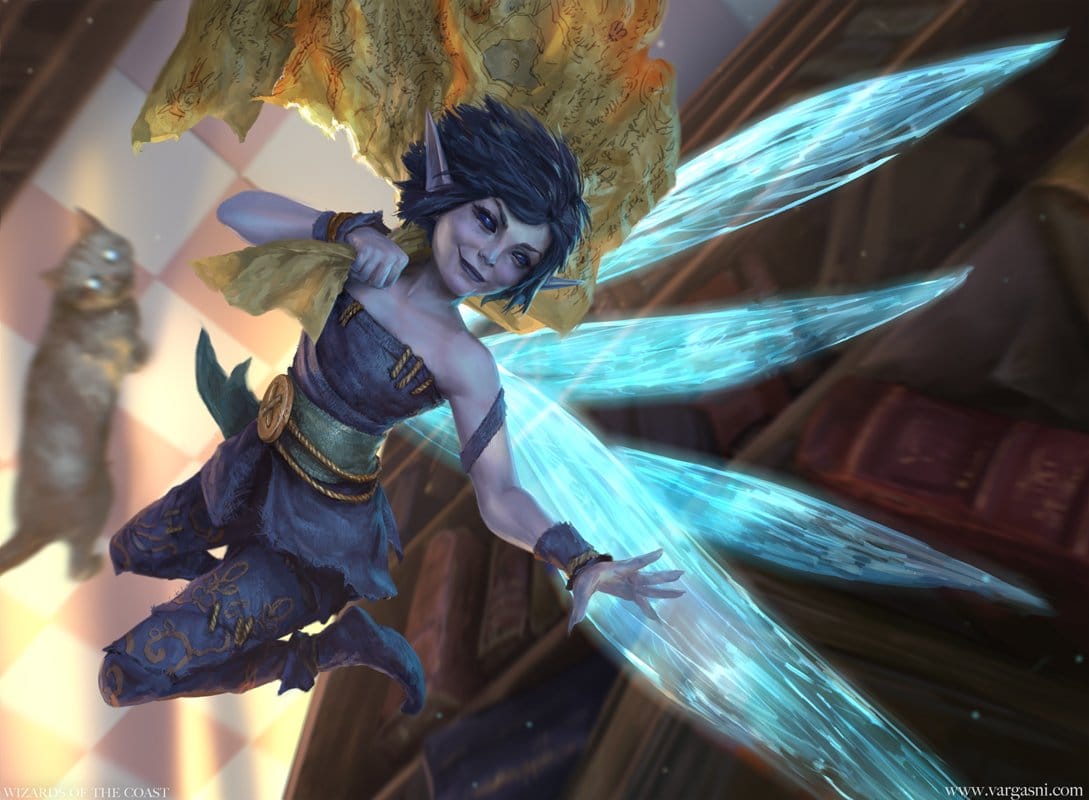Fairy Guide 5e
Published on March 6, 2022, Last modified on May 16th, 2022

Randy Vargas - Wizards of the Coast - Tome Raider
What is this guide?
This guide is meant to give you an idea of whether or not the fairy will be right for your 5e character build.
The color code below has been implemented to help you identify, at a glance, how good that option will be for your fairy. This color coding isn’t a hard and fast rule; there are plenty of sub-optimized options out there that will be viable to your party and will be fun to play.
- Black is a trait shared by many races and or will not impact the effectiveness of your character build
- Red isn’t going to contribute to the effectiveness of your character build at all
- Orange Situationally good, but a below-average option otherwise
- Green is a good option
- Blue is a great option, you should strongly consider this option for your character
- Sky Blue is an amazing option. If you do not take this option your character would not be optimized
Tasha's Cauldron of Everything Update
Tasha's Cauldron of Everything has added the "Customizing Your Origin" option that may affect the ability score increases, languages, and proficiencies in this guide. To read more about this, visit our D&D Race Guide.
What are Fairies in 5e?
Source: The Wild Beyond The Witchlight
Fairies are small, winged folk the originated from the Feywild. Most fairies appear as miniature elves with insectile wings, but like other races, each has their own distinguishing features. Due to their connection with the Feywild, fairies are innately magical and have a whimsical nature that is ruled by impulse and emotion.
Fairy 5e Traits
Ability Score Increases: Being able to choose between +2 ASI, +1 ASI, or +1, +1, +1 ASI means that you can pick exactly what your build will need.
Creature Type: Being the fey creature type allows you to avoid some pretty nasty spells, like hold and dominate person. You are more susceptible to other spells, like hallow and protection from evil and good, but these aren’t as bad as the spells you gain immunity to. Your biggest worry with being a fey is the banishment spell, though this is more effected by your backstory than your creature type.
Size: A Small size comes with some drawbacks, such as wielding certain weapons and grappling. On the other side, Small creatures are better at hiding and can more easily move around the battlefield. In the fairies’ case, the Small size’s drawbacks are quite significant because it restricts use of heavy ranged weapons, which would compliment the free, concentrationless flight they get at 1st level.
Speed: Maintaining a standard walking speed is great considering that fairies are Small creatures.
Fairy Magic: The druidcraft cantrip isn’t particularly impressive, probably the most helpful thing it can do is forecast the weather for the coming 24 hours. Faerie fire is a decent spell to have at your disposal as getting advantage on attacks against creatures for multiple rounds can wind up in a lot of damage. Always having a response for invisible enemies also helps ensure you’re not caught off guard. Enlarge/reduce can help combat more appealing for STR-based classes (once per day, at least) and can offer some shenanigans by being able to shrink to a Tiny sized creature.
Flight: 1st level, concentrationless flight is always an extremely strong racial ability. Unfortunately, their Small size restricts the ability to use heavy ranged weapons, which removes some of the best advantages that this ability offers. Of course, the free casting of enlarge/reduce can help mitigate that, but it’s only available once you hit 5th level and can only cast is once a day unless you have the spell slots necessary to recast.
Sources Used in This Guide
- BR: Basic Rules
- GotG: Bigby Presents: Glory of the Giants
- SotDQ: Dragonlance: Shadow of the Dragon Queen
- ERLW: Eberron: Rising from the Last War
- EEPC: Elemental Evil Player’s Companion
- EGtW: Explorer’s Guide to Wildemount
- FToD: Fizban's Treasury of Dragon
- GGtR: Guildmasters' Guide to Ravnica
- MotM: Monsters of the Multiverse
- MToF: Mordenkainen’s Tome of Foes
- MOoT: Mythic Odyessys of Theros
- PAitM: Planescape: Adventures in the Multiverse
- PHB: Player's Handbook
- SAiS: Spelljammer: Adventures in Space
- SCoC: Strixhaven: A Curriculum of Chaos
- SCAG: Sword Coast Adventurer’s Guide
- TCoE: Tasha’s Cauldron of Everything
- TTP: The Tortle Package
- WBtW: The Wild Beyond The Witchlight
- VRGtR: Van Richten's Guide to Ravenloft
- VGtM: Volo's Guide to Monsters
- XGtE: Xanathar’s Guide to Everything
